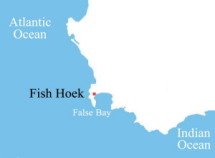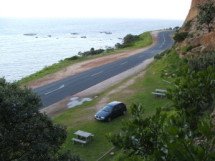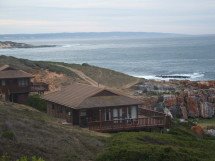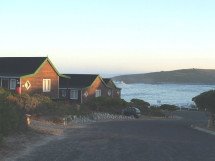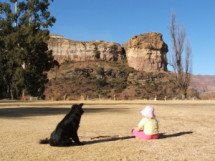 Google Earth Image showing the dx locations of Fish Hoek and Castle Rock, Cape Peninsula, South Africa.Castle Rock, Cape Peninsula, South Africa
Google Earth Image showing the dx locations of Fish Hoek and Castle Rock, Cape Peninsula, South Africa.Castle Rock, Cape Peninsula, South AfricaCastle Rock is situated in a picturesque marine reserve just south of Millers Point on the Cape Peninsula. The remote conservation area has some of the most impressive views over False Bay. It is a short 20 minute drive from my QTH at Fish Hoek to an excellent elevated coastal position which is especially suited to early evening dxing. The isolated dx location is very quiet for dx reception with no local electrical noise sources to contend with - a huge advantage when trying to dig out long haul dx or distant low power stations that would be difficult or impossible to hear in Fish Hoek's more urban environment.
 Google Earth Image showing the dx location at Castle Rock, situated south of Millers Point along the winding coastal road overlooking False Bay .
Google Earth Image showing the dx location at Castle Rock, situated south of Millers Point along the winding coastal road overlooking False Bay .The South African dxer is in a fortunate position with few local stations to contend with and utilising the non-directional properties of a relatively short antenna at Castle Rock allows for the reception of quite a variety of TIO (Trans-Indian Ocean) and African/Middle East DX. It's interesting to hear distant stations fight it out on certain frequencies in line with constantly changing propagation conditions.
A visit to Castle Rock during the evenings of the 15th and 16th October 2010 produced a few interesting stations despite average reception conditions with some moderate static.
 The dx location with the mountainside towards the west.Highlights
The dx location with the mountainside towards the west.HighlightsThe tentative reception of SBC Victoria, Seychelles on 1386 khz (10 kw) and fair peaks from 3ABN Busselton Western Austalia on 1629 kHz (400 watts) occured. Huge consistent "local" quality peaks from 6WF Perth on 720 kHz was quite astonishing - it is usually the most consistent of the Australian mediumwave stations received here. HLAZ Juju, South Korea owned 1566 kHz with some remarkable clear peaks - no sign of co-channel AIR Nagpur, India which has the reputation of quite a balanced fight with HLAZ. Radio Tanzania, Mwanza blew the usually dominant co-channel 6WF out of the water on 720 khz via the 220 metre BOG which was aligned towards the north, along the left hand side of the road, during the later part of the evening.
 Another view of the dx location with convenient picnic site tables.The Loggings
Another view of the dx location with convenient picnic site tables.The Loggings (
mp3 audio clips have been included below).
Freq (kHz) Time (UTC)594 2002 MALAWI MBC Radio 1 Lilongwe in Chichewa // 756 kHz 16 Oct *
612 1806 AUSTRALIA 6RN Dalwallinu w Radio National programming 15 Oct
666 1912 REUNION Radiodiffusion Vision Réunion St.Pierre in FF 15 Oct
684 1736 MAURITIUS Radio Maurice Malherbes
mp3 audio clip in FF w pops 16 Oct
684 1840 AUSTRALIA 6BS Busselton w mx interlude // 720 6WF 15 Oct
702 1838 AUSTRALIA 6KP Karratha w detailed wx rpt // 720 6WF 15 Oct
720 1834 AUSTRALIA 6WF Perth
mp3 audio clip w wx - consistent with excellent "local" quality peaks (8 685 km / 5 397 miles) 15 Oct
 Google Earth Image of the 6WF 720 kHz 180 metre mast with a "top hat", located in Hamersley, Perth, Western Australia.
Google Earth Image of the 6WF 720 kHz 180 metre mast with a "top hat", located in Hamersley, Perth, Western Australia.720 2024 TANZANIA Radio Tanzania Mwanza
mp3 audio clip in Swahili w local music 15 Oct *
729 1852 AUSTRALIA 5RN Adelaide w human interest report 15 Oct
729 2015 GREECE GRC NET Athínai 15 Oct *
747 1842 AUSTRALIA 6SE Radio West Esperance w ads 15 Oct
756 2002 MALAWI MBC Blantyre in Chichewa 16 Oct *
774 1841 AUSTRALIA 3LO Melbourne // 720 6WF 15 Oct
810 1820 AUSTRALIA 6RN Perth under Mozambique 15 Oct
882 1740 AUSTRALIA 6PR Perth w ad 15 Oct
891 1820 AUSTRALIA 5AN ABC Adelaide under Lesotho 15 Oct
990 1747 AUSTRALIA 6RPH Perth w BBC relay 15 Oct
1044 1815 AUSTRALIA 5CS Port Pirie w classic hits 15 Oct
1098 1748 AUSTRALIA 6MD Radio West Merredin 15 Oct
1098 1934 TAIWAN Radio Free Asia in Mandarin 16 Oct
1134 1927 KENYA KBC Kitale 16 Oct
1143 1933 TAIWAN Taiwan Area Fishery Broadcasting Station Penghu w music 15 Oct
1152 1918 AUSTRALIA 6PNN Busselton w ABC News Radio programming 15 Oct
1242 1737 AUSTRALIA 5AU Port Augusta w ads 15 Oct
1242 1924 JAPAN JOLF Tokyo in JJ 15 Oct
1242 1940 FRANCE France Info, Marseille-Cabriès-Réaltor in FF 15 Oct
1296 1721 AUSTRALIA 6RN Wagin w interview15 Oct
1323 1804 AUSTRALIA 5DN Adelaide w classic hits 15 Oct
1368 1738 SEYCHELLES SBC Victoria
mp3 audio clip (tentative) w ann on top of overdrive lead guitar rock music bed - very poor 15 Oct
1359 1720 TAIWAN Family Radio 15 Oct
1395 1832 AUSTRALIA 5AA Adelaide w news 15 Oct
1404 1755 AUSTRALIA 6TAB Busselton w discussion //1449 kHz 15 Oct
1404 2002 MALAWI MBC Chitpa in Chichewa // 756 kHz 16 Oct *
1413 1854 JAPAN Fukuoka in JJ under Oman 16 Oct
1422 2002 MALAWI MBC Matiya in Chichewa // 756 kHz 16 Oct *
1431 1709 DJIBOUTI Radio Sawa Arta w id 15 Oct
1440 2004 TANZANIA Radio One w EE id jingle mp3 16 Oct *
1449 1755 AUSTRALIA 6TAB Mandurah w discussion //1404 kHz 15 Oct
1458 1708 MAYOTTE Radio Vision Mayotte Pamandzi in FF 15 Oct
1458 1923 ANGOLA Emissora Provincial do Moxico Luena in PP 16 Oct
1503 1735 TAIWAN Family Radio Fangliao mp3 in Vietnamese 15 Oct
1548 1712 AUSTRALIA 4QD Emerald w talkback under Radio Islam Lenasia 15 Oct
1557 1920 TAIWAN Family Radio Kouhu in EE 15 Oct
1566 1729 SOUTH KOREA HLAZ Jeju
mp3 audio clip (13 482 km / 8 377 miles) 15 Oct
 Google Earth Image of the HLAZ 1566 khz antenna masts, located in Jeju Province, South Korea.
Google Earth Image of the HLAZ 1566 khz antenna masts, located in Jeju Province, South Korea.1566 1848 AUSTRALIA 3NE Wangaratta w ad and id 15 Oct
1575 1812 MAURITIUS BBC World Service Relay Bigara w interview 15 Oct
1593 1701 CHINA CNR1 Changzhou in CC 15 Oct
1611 1822 VISION Radio Network Margaret River w Christian programme 15 Oct
1629 1758 AUSTRALIA 3ABN Busselton
mp3 audio clip (8 545 km / 5 310 miles) w Christian programme 15 Oct
 The 3ABN 1629 kHz 30 metre AM mast with a "top hat", situated just north of Busselton (Photograph with kind permission from Rosemary Malkiewycz).Receiver :
The 3ABN 1629 kHz 30 metre AM mast with a "top hat", situated just north of Busselton (Photograph with kind permission from Rosemary Malkiewycz).Receiver : Sony SRF-M37V ULR
Antenna : Most stations were received inductively via a modest 30 metre sloper antenna directed towards the north. Stations indicated with an asterix * were heard inductively via the 220 metre BOG directed along the left hand side ot the road towards the north.
 Philips was next with their two, three and four valve table models with separate speakers followed by the Loewe "Three in One" set.
Philips was next with their two, three and four valve table models with separate speakers followed by the Loewe "Three in One" set.



















































